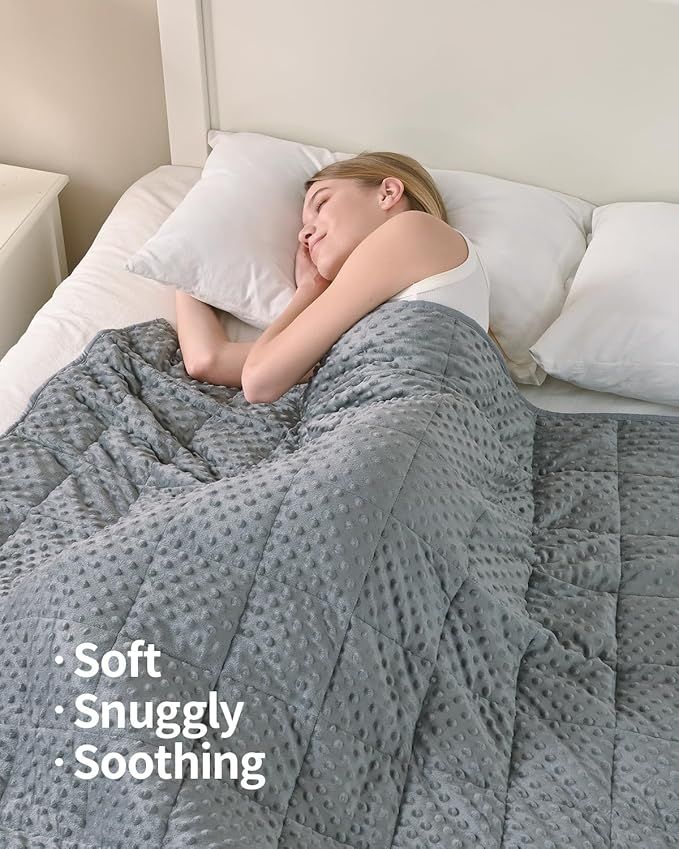Weighted Blankets
When sleep isn’t easy, swaddling offers a comforting cuddle.

Please note: All images used here are those of our affiliate partners. We rely on commissions from our affiliate partners to fund this site and appreciate your support. Thank you.
Weighted Blankets
Weighted Blankets - Why?
What Is a Weighted Blanket and How Does It Work for Sleep?
Sleep has a way of restoring us in ways nothing else can. Yet for many people, sleep does not always come easily. Whether it is racing thoughts, restless tossing, or the simple struggle of winding down, finding comfort at night can sometimes feel like chasing a moving target. That is why weighted blankets have become such a popular topic. People are curious not only about how they feel but also about whether they truly make a difference. If you’ve ever asked yourself, what is a weighted blanket, and how does it work?, you are not alone. This guide explores both the comfort and the safety concerns of weighted blankets, offering a clear and friendly look at what they bring to the world of sleep.
Understanding Weighted Blankets
A weighted blanket is designed to be heavier than a typical blanket, usually filled with glass beads, plastic pellets, or other dense materials to create a gentle, even pressure across the body.
This added weight is not random. It is carefully measured to provide something called “deep pressure stimulation,” which mimics the feeling of being held, hugged, or swaddled. For many people, this sensation is soothing, helping them feel calmer and more secure when lying in bed. Unlike ordinary blankets, which focus solely on warmth and softness, weighted blankets are designed to create a safe, steady pressure that affects the nervous system.
The Science of Deep Pressure Stimulation
The principle behind weighted blankets comes from the therapeutic technique known as deep pressure stimulation.
When gentle, even pressure is applied to the body, it signals the nervous system to slow down and shift into a calmer state. Stress hormones, such as cortisol, are reduced, while feel-good chemicals like serotonin and melatonin are encouraged. Serotonin helps regulate mood, while melatonin plays a direct role in preparing the body for sleep.
This is why so many people describe the weighted blanket experience as comforting, grounding, or even sleep-transforming. It is not magic—it is biology, harnessed in a very practical and tangible way.
How Weighted Blankets Affect Sleep
The main effect of a weighted blanket is to create a cocoon-like sense of calm, which may help people fall asleep faster and stay asleep longer.
When the body feels settled, the mind often follows. A weighted blanket does not “knock you out,” but it can ease the transition from wakefulness to rest. People who deal with anxiety, stress, or restlessness sometimes find that the gentle weight helps keep them still, reducing tossing and turning through the night.
For some, the sensation feels similar to being tucked in or embraced. That sense of security can be especially powerful when the mind is racing or the body feels unsettled.
Safety Concerns and Considerations
While weighted blankets can be deeply comforting, it is important to recognise that they are not suitable for everyone and must be chosen with care.
Weighted blankets should typically weigh about 8–12% of a person’s body weight. Using one that is too heavy can restrict movement, cause overheating, or feel overwhelming instead of relaxing.
For children, older adults, or individuals with breathing or circulation issues, caution is particularly important. Weighted blankets are not recommended for infants or toddlers under any circumstances, as they pose serious safety risks.
People with conditions such as asthma, sleep apnea, or chronic respiratory difficulties should consult a healthcare provider before using one, as the added weight may exacerbate their breathing difficulties. The goal of a weighted blanket is to provide comfort and calm, not to take a risk.
Different Types of Weighted Blankets
Weighted blankets vary not only in their weight but also in materials, design, and construction, making it important to understand the differences.
Some are filled with micro glass beads, which are small, smooth, and evenly distributed. Others use plastic pellets, which can feel slightly bulkier. Newer designs sometimes use layers of dense fabric instead of beads at all.
Covers also make a difference. Cotton covers are breathable, keeping the blanket cooler, while fleece or minky fabrics feel softer and cosier but may trap heat. The right choice often depends on whether someone tends to sleep hot or prefers extra warmth at night.
Who Might Benefit from Weighted Blankets?
Weighted blankets may be particularly helpful for people who struggle with anxiety, restlessness, or trouble staying asleep.
Some users report fewer night wakings, while others describe a general sense of relaxation that makes winding down at bedtime easier. Individuals with sensory sensitivities often find the deep pressure grounding, which can be especially soothing in stressful environments.
That said, weighted blankets are not a cure-all. They do not eliminate chronic sleep disorders or replace medical treatment. Instead, they act as a supportive tool—a way to enhance comfort and create an environment where better sleep is more possible.
Caring for a Weighted Blanket
Because weighted blankets are heavier than normal bedding, caring for them requires extra attention.
Not all washing machines can handle the weight of these blankets, particularly those on the heavier end. Some designs have removable covers that can be washed separately, while others require spot cleaning or professional laundering. Following care instructions carefully is important to keep the blanket safe, hygienic, and long-lasting.
How to Use a Weighted Blanket Safely
The safest way to use a weighted blanket is to ensure it matches your body size and allows for comfortable movement and breathing.
The blanket should cover the body but not be so large or heavy that it spills over the edges of the bed and makes repositioning difficult. It should never cover the face or restrict airflow.
It is also best to introduce the blanket gradually. Some people may need time to adjust to the sensation of weight. Starting with short naps or relaxing under the blanket while awake can help the body adapt.
Final Thoughts on Weighted Blankets
So, what is a weighted blanket, and how does it work? It is more than just a heavier quilt. It is a carefully designed tool that uses gentle, even pressure to calm the nervous system and promote rest. For many, it provides a sense of safety and comfort that transforms the way they sleep.
But as comforting as it can be, it must be chosen and used wisely. Safe weight, breathable materials, and personal health considerations should always guide the decision. A weighted blanket should feel like a hug, not a burden. With the right approach, it can become a supportive part of a bedtime routine, helping the body and mind find the calm they need.




